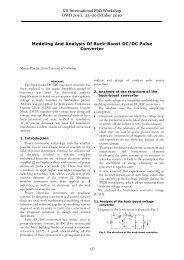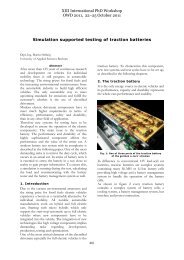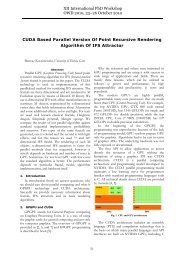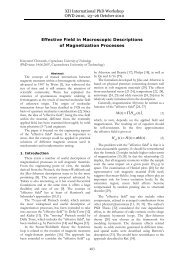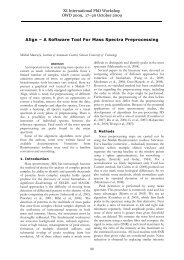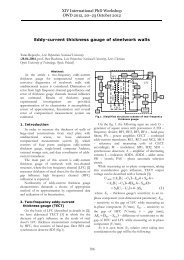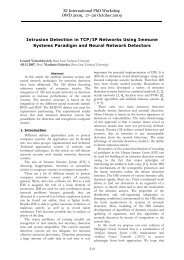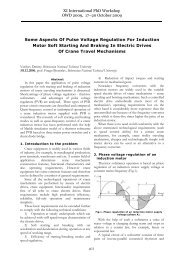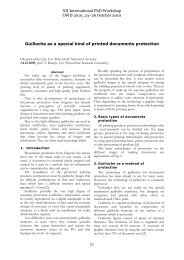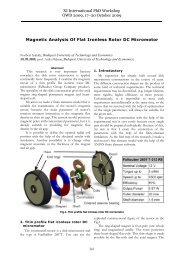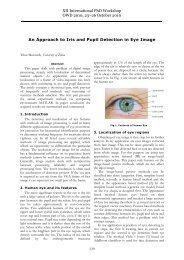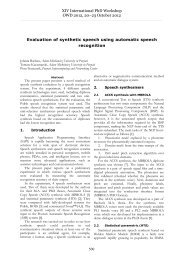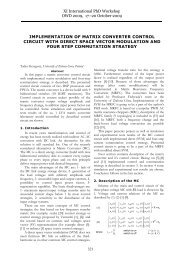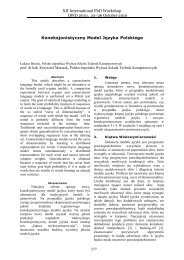Diagnostics Of Asynchronous Motors Based On Spectra Analysis Of ...
Diagnostics Of Asynchronous Motors Based On Spectra Analysis Of ...
Diagnostics Of Asynchronous Motors Based On Spectra Analysis Of ...
You also want an ePaper? Increase the reach of your titles
YUMPU automatically turns print PDFs into web optimized ePapers that Google loves.
( K<br />
a) b)<br />
Fig. 3 Three-phase (a) and phase A (b) spectra of motor<br />
with bad mounting.<br />
So, if the following rule is correct:<br />
npτ<br />
(A)<br />
∧ ( P<br />
avg А2<br />
= K<br />
= P<br />
npτ<br />
(B)<br />
avg B2<br />
= K<br />
= P<br />
npτ<br />
(C)<br />
avg C 2<br />
= 1)<br />
∧ ( K<br />
= 0,<br />
33)<br />
∧<br />
t hh<br />
> 0,<br />
02)<br />
∧<br />
∧ ( ε pA = ε pB = ε pС ) ∧ ( K harm(6-<br />
45) > 0,<br />
75)<br />
= 1,<br />
that examined motor is badly mounted.<br />
When rotor is dynamic or static misbalanced,<br />
there is harmonic in three-phase power spectra,<br />
which relates to rotation frequency. Thus, when noload,<br />
there is harmonic with frequency 100p in threephase<br />
power spectra (here p – number of ports). So,<br />
if there is significant component with rotation<br />
frequency in three-phase power spectra, and<br />
weighted average quotients are not equivalent by<br />
phases, that motor has asymmetry. And if there is<br />
significant value of harmonic amplitudes of 156–<br />
195 Hz, that asymmetry is caused by unbalance.<br />
a) b)<br />
Fig. 4 Three-phase (a) and phase A (b) power spectra of<br />
motor with rotor unbalance.<br />
So, for detecting rotor unbalance, the following<br />
rule should be true:<br />
( ε > 0,<br />
05)<br />
∧ ( ε ≠ ε ≠ ε<br />
p2<br />
∧ ( P<br />
avg А2<br />
≠ P<br />
avg B2<br />
pA<br />
≠ P<br />
pB<br />
avg C 2<br />
) ∧ ( K<br />
) ∧ ( K<br />
t hh<br />
harm(156-195)<br />
> 0,<br />
02)<br />
> 0,<br />
1)<br />
∧ ( Kharm(196-<br />
205) > 0,<br />
45)<br />
= 1.<br />
In case of stator windings asymmetry and stator<br />
windings short-circuits, there is significant harmonics<br />
of double voltage frequency and little less then 4 f v<br />
frequency (fig. 5 a, fig. 6, a). When damages are<br />
worse, this harmonics grow. Low-frequency<br />
harmonics (5–45 Hz) also grow, however its<br />
frequency is constant. Main percent of high<br />
harmonics for phases is in range of 96–105 Hz. Also<br />
significant percent is from range of 196–205 Hz (fig.<br />
5, b; fig. 6, b). When both kinds of damages are<br />
caused, values of formulated indicators are almost<br />
equal. Thus, if there is main harmonic with double<br />
voltage frequency and significant harmonic of little<br />
less then 4 f v frequency, and significant degradation<br />
of formulated indicators, that there is windings<br />
asymmetry or windings short-circuits.<br />
a) b)<br />
Fig. 5 Three-phase (a) and phase A (b) spectra of motor<br />
with asymmetry of phase A.<br />
pС<br />
(<br />
437<br />
( K<br />
( P<br />
(( K<br />
a) b)<br />
Fig. 6 Three-phase (a) and phase A (b) spectra of motor<br />
with stator winding short circuits.<br />
So, if the following rule is correct:<br />
> 0,<br />
02)<br />
∧ ( K ≠ K ≠ K<br />
ε p2<br />
npτ<br />
(A) npτ<br />
(B) npτ<br />
(C)<br />
∧ ( ε < 0,<br />
98)<br />
∧ ( ε<br />
p<br />
lq v<br />
avg А2<br />
> 0,<br />
05)<br />
∧ ( K<br />
harm(196<br />
≠ P<br />
avg B2<br />
- 205)<br />
> K<br />
pA<br />
rec t<br />
≠ P<br />
≠ ε<br />
< 0,<br />
97)<br />
∧<br />
avg C 2<br />
pB<br />
harm(156-195)<br />
≠ ε<br />
) ∧ (( K<br />
) ∨<br />
pС<br />
) ∧<br />
harm(96-105)<br />
)<br />
> 0,<br />
99)<br />
∧<br />
( Kharm(196-<br />
205) ≈ Kharm(156-195)<br />
)) = 1,<br />
then there is either windings asymmetry or windings<br />
short-circuits.<br />
When rotor bar breaks, there is only low<br />
frequency component in three-phase power spectra<br />
(fig. 7, a). It grows when progresses defect.<br />
Remaining indicators change negligibly and there is<br />
no asymmetry of examined parameters, because<br />
changing of rotor parameters appears indirect in<br />
changing of stator parameters. Additional indicator<br />
for identifying this defect is subharmonics of voltage<br />
frequency in current spectra [3]. Thus, if there is low<br />
frequency component of three-phase power signal,<br />
also subharmonics of main voltage frequency<br />
harmonic in current spectra, non-equal weighted<br />
average quotients and almost optimal ε p , K rec t ,<br />
then motor has rotor bar breaks.<br />
a) b)<br />
Fig. 7 Three-phase (a) and phase A (b) spectra of motor<br />
with rotor winding bar break.<br />
For detecting this defect, the following rule must<br />
be correct:<br />
( K ≠ K ≠ K ) ∧ ( ε ≈ ε ≈ ε )<br />
npτ<br />
(A)<br />
∧ ( K<br />
t hh<br />
npτ<br />
(B)<br />
> 0,<br />
02 ) ∧ ( P<br />
npτ<br />
(C)<br />
avg А2<br />
≠ P<br />
pA<br />
avg B2<br />
≠ P<br />
pB<br />
avg C 2<br />
) ∧<br />
∧ ( Kharm(6<br />
- 45) > 0,<br />
8 ) = 1.<br />
Thus, observing for variation of formulated<br />
indicators, it is possible to make conclusion about<br />
appearing of some kinds of defects or non-qualities<br />
of asynchronous electric drive systems. Analyzing<br />
values of some indicators it is possible to make<br />
conclusion about current work mode allowability.<br />
Also it is possible to prognosis remaining resource<br />
analyzing non equal phase heating basis on "eight<br />
degree" rule. When some defects are present for one<br />
motor at the same time, percent of harmonics from<br />
frequency ranges for each defect will be less than if it<br />
pС



